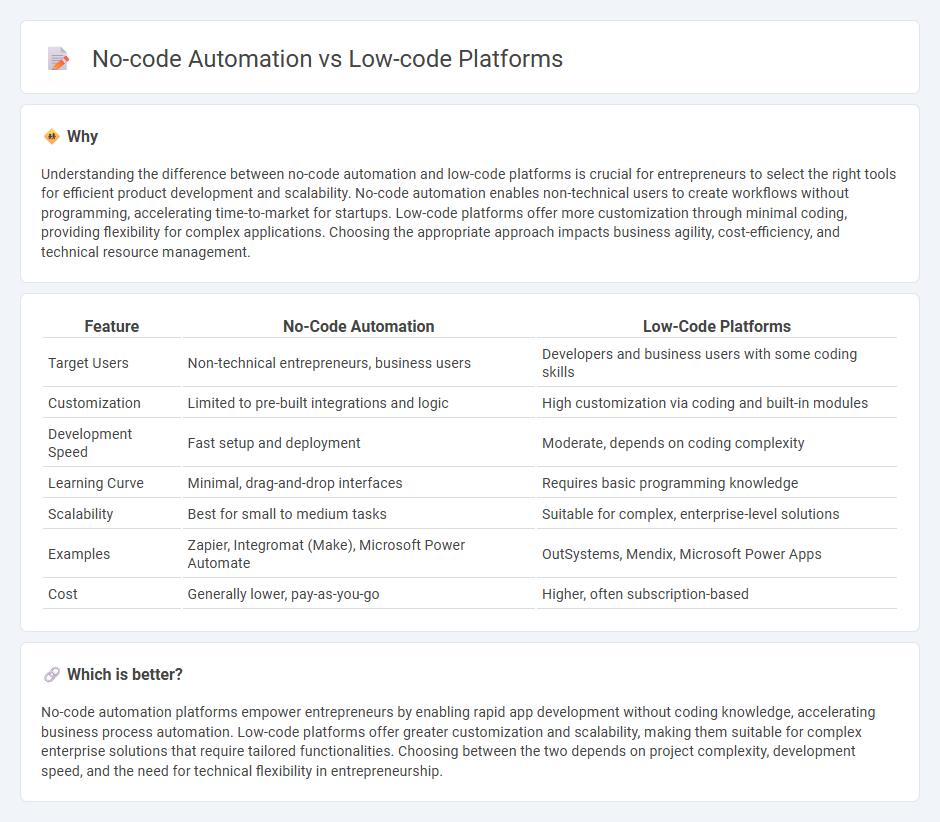
No-code automation empowers entrepreneurs to build workflows and applications without programming knowledge, significantly accelerating product development and reducing time-to-market. Low-code platforms offer a balance by enabling both visual development and custom coding, providing greater flexibility for more complex solutions. Explore how these innovative technologies can streamline your startup's operations and foster scalable growth.
Why it is important
Understanding the difference between no-code automation and low-code platforms is crucial for entrepreneurs to select the right tools for efficient product development and scalability. No-code automation enables non-technical users to create workflows without programming, accelerating time-to-market for startups. Low-code platforms offer more customization through minimal coding, providing flexibility for complex applications. Choosing the appropriate approach impacts business agility, cost-efficiency, and technical resource management.
Comparison Table
| Feature | No-Code Automation | Low-Code Platforms |
|---|---|---|
| Target Users | Non-technical entrepreneurs, business users | Developers and business users with some coding skills |
| Customization | Limited to pre-built integrations and logic | High customization via coding and built-in modules |
| Development Speed | Fast setup and deployment | Moderate, depends on coding complexity |
| Learning Curve | Minimal, drag-and-drop interfaces | Requires basic programming knowledge |
| Scalability | Best for small to medium tasks | Suitable for complex, enterprise-level solutions |
| Examples | Zapier, Integromat (Make), Microsoft Power Automate | OutSystems, Mendix, Microsoft Power Apps |
| Cost | Generally lower, pay-as-you-go | Higher, often subscription-based |
Which is better?
No-code automation platforms empower entrepreneurs by enabling rapid app development without coding knowledge, accelerating business process automation. Low-code platforms offer greater customization and scalability, making them suitable for complex enterprise solutions that require tailored functionalities. Choosing between the two depends on project complexity, development speed, and the need for technical flexibility in entrepreneurship.
Connection
No-code automation and low-code platforms accelerate entrepreneurship by reducing technical barriers, enabling founders to develop and scale products rapidly without extensive coding skills. These tools streamline workflow automation, product development, and deployment, which lowers operational costs and shortens time-to-market. The synergy between no-code and low-code solutions fosters innovation by empowering entrepreneurs to prototype, iterate, and launch digital solutions efficiently.
Key Terms
Customization
Low-code platforms offer extensive customization options by allowing developers to write custom code alongside visual design tools, enabling tailored workflows and integrations to meet complex business needs. No-code automation tools prioritize ease of use with pre-built templates and drag-and-drop interfaces, but they often limit customization to predefined functionalities. Explore the differences further to determine which approach best suits your organization's automation strategy.
Technical Expertise
Low-code platforms require some level of technical expertise, allowing developers to customize applications with minimal hand-coding, while no-code automation targets business users with zero coding skills by offering drag-and-drop interfaces for quick deployment. Low-code solutions provide greater flexibility and scalability for complex workflows, whereas no-code tools prioritize speed and ease of use for straightforward tasks. Explore the distinctions between low-code and no-code automation to find the best fit for your team's technical capabilities and business goals.
Workflow Automation
Low-code platforms offer customizable workflow automation with limited coding, enabling developers to tailor processes while accelerating deployment. No-code automation prioritizes ease of use with drag-and-drop interfaces, allowing business users to create workflows without technical skills. Explore our in-depth comparison to discover which solution fits your automation needs best.
Source and External Links
Top 10 Open-Source Low-Code Platforms to Streamline Business - Lists Skyve, Baserow, Joget, and others as top open-source low-code platforms that enable rapid business app development with minimal coding, supporting both web and mobile, with options for free trials and scalable pricing models.
Best Enterprise Low-Code Application Platforms Reviews 2025 - Highlights Joget and Quixy as enterprise-grade platforms that combine visual development, business process automation, and API integration for non-coders and developers alike, emphasizing support for complex data structures, extensibility, and collaboration.
Low-Code Development: A Guide for IT Leaders - OutSystems - OutSystems is a leading low-code platform recognized for its visual, drag-and-drop environment, AI capabilities, scalability, and strong support for both beginners and advanced developers, helping organizations accelerate app delivery and reduce backlogs.
 dowidth.com
dowidth.com